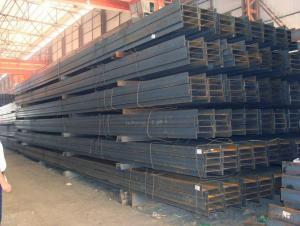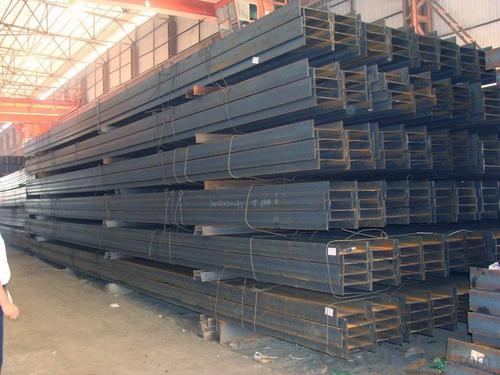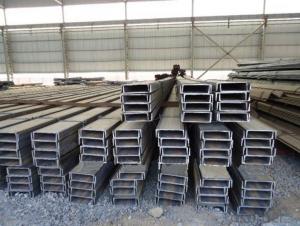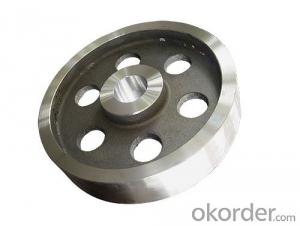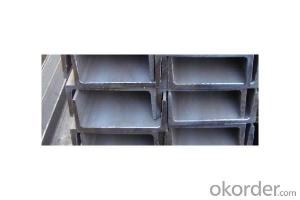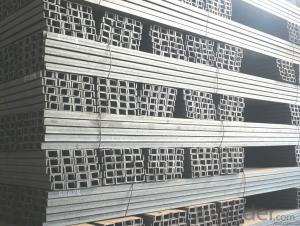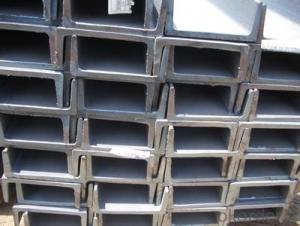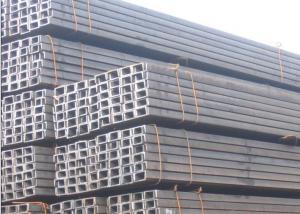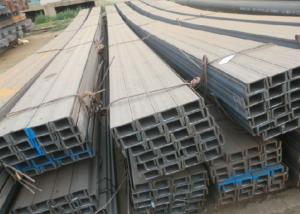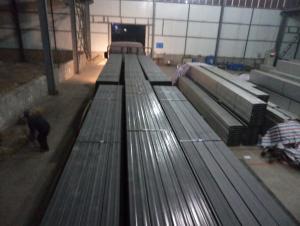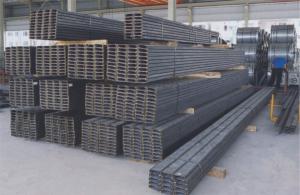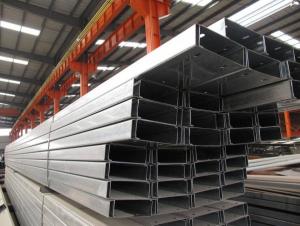Hot Rolled Channel Stee for Construction Use of High Quality
- Loading Port:
- Qingdao
- Payment Terms:
- TT OR LC
- Min Order Qty:
- 2000 PCS
- Supply Capability:
- 40000 PCS/month
OKorder Service Pledge
OKorder Financial Service
You Might Also Like
High Quality Hot Rolled Channel Steel/ Channel Iron/Steel Channel for Construction Use Details
Standard: | GB,JIS | Dimensions: | 50*25-125*65mm | Grade: | Q235 or SS400 |
Place of Origin: | China (Mainland) | Brand Name: | CNBM | Model Number: | 50*25-125*65mm |
Shape: | U Channel | Application: | Construction | Perforated Or Not: | Not Perforated |
Packaging & Delivery
Packaging Detail: | standard seaworthy packing |
Delivery Detail: | about 15-30 days after receiving the deposit or LC |
High Quality Hot Rolled Channel Steel/ Channel Iron/Steel Channel for Construction Use Specifications:
1.Hot rolled channel steel for construction use
2.Size:50*25mm-125*65mm
3.Material:Q235/SS400
4.Length:6m or 12m
5.Standard:JIS
6.Tolerance:8-12%, or according to your requirements.
High Quality Hot Rolled Channel Steel/ Channel Iron/Steel Channel for Construction Use Pictures
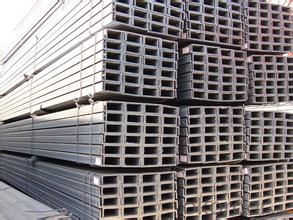

- Q: Are steel channels suitable for railway tracks?
- Steel channels are not suitable for railway tracks. Railway tracks require a specific type of steel rail that is designed to withstand the heavy loads and constant use of trains. Steel channels, on the other hand, are typically used in construction for structural support and do not have the necessary strength and durability to serve as railway tracks. Additionally, steel channels lack the necessary shape and design features, such as the proper rail profile and fastening system, required for safe and efficient railway operations. Therefore, it is essential to use dedicated steel rails specifically designed for railway tracks to ensure the safety and functionality of the railway system.
- Q: How are steel channels protected against rust and corrosion?
- Steel channels are protected against rust and corrosion through various methods such as galvanization, coating with protective paints or sealants, and applying corrosion-resistant treatments to the surface.
- Q: What are the common loadings considered in the design of steel channels?
- The common loadings considered in the design of steel channels include dead loads, live loads, wind loads, seismic loads, and impact loads. Dead loads are the permanent loads that the channel will support, such as the weight of the structure itself and any fixed equipment. Live loads are temporary loads that the channel will experience, such as the weight of people, furniture, or vehicles. Wind loads consider the force exerted by wind on the structure, which can vary based on the location and the design wind speed. Seismic loads account for the potential ground motion during an earthquake. Impact loads take into account any sudden or dynamic loads that may occur, such as a collision or a heavy object being dropped on the channel.
- Q: What does "deformed L/200" mean in the carrying capacity of channel steel?
- Most of the traditional bridge deflection measurement using a dial gauge or displacement gauge measurement, the current safety assessment in the old bridge or bridge acceptance is still widely used in China, the maintenance of the bridge. The advantage of this method is that the equipment is simple and can be used for multi-point detection. The deflection values of each measuring point are obtained directly, and the measurement results are stable and reliable. But the direct measurement method has many deficiencies, the method requires measuring point pull wire or erection shelf at all, to be measured directly with water under the bridge so; to overpass, affected by railway or highway traffic bound, the method can also be used; across the canyon and other Takahashi also cannot use the direct method of measurement in addition to using direct method; deflection measurement, regardless of layout or revoke the instrument, are relatively complicated time-consuming.
- Q: How do steel channels contribute to the stability of structures?
- Steel channels contribute to the stability of structures in several ways. Firstly, they provide structural support by distributing the load evenly across their length. This helps to prevent excessive stress or strain on any particular section of the structure, thereby increasing its overall stability. Additionally, steel channels are often used as beams or columns in construction. As beams, they help to bear the weight of the structure and transfer it to the foundation. This ensures that the structure remains stable and does not collapse under the applied loads. As columns, steel channels provide vertical support, preventing buckling or bending of the structure under compression forces. Moreover, steel channels can be used as braces, which further enhance the stability of a structure. Braces are diagonal members that connect different parts of a structure, improving its resistance to lateral forces such as wind or earthquakes. By providing additional rigidity and stiffness, steel channels help to reduce the risk of structural failure or collapse during such events. Furthermore, steel channels offer high strength and durability, making them ideal for supporting heavy loads and withstanding extreme conditions. Their resistance to corrosion and deterioration ensures the long-term stability of the structure. Steel channels also have a high load-carrying capacity, allowing for the construction of larger and more complex structures with increased stability. In summary, steel channels contribute to the stability of structures by providing structural support, distributing loads evenly, bearing weight, preventing buckling or bending, acting as braces, and offering high strength and durability. Their use in construction enhances the overall stability and safety of buildings, bridges, and other structures, ensuring their longevity and resistance to various external forces.
- Q: 6.3# how long is the channel length?
- Standard Specification for dimensions, weights and specifications for hot rolled ordinary channel steels:6.3# channel steel *6/7/8/9 meters hot rolled channel 63*40*4.8 length length, the specific data can refer to the following table painted red line.
- Q: What are the precautions for handling and storing steel channels?
- To ensure the safety of individuals and the integrity of steel channels when handling and storing them, it is crucial to take specific precautions. Consider the following measures: 1. Personal Protective Equipment (PPE): It is essential to wear suitable PPE, including gloves, safety glasses, and steel-toed boots, when handling steel channels. This will protect against sharp edges, potential falls, and other hazards. 2. Lifting and handling: Utilize correct lifting techniques and equipment, such as cranes or forklifts, to move and transport steel channels. Avoid dragging or sliding them, as this may cause material damage or accidents. 3. Secure storage: Store steel channels securely and in an organized manner to prevent falls or injuries. Stack them on a flat surface or use racks specifically designed for this purpose. Ensure that the storage area is free from moisture, direct sunlight, and extreme temperatures, as these factors can cause corrosion or distortion. 4. Weight capacity: Be aware of the weight capacity of the storage area or racks. Overloading can lead to collapse or damage to the material. 5. Rust prevention: Apply a protective coating or oil to the steel channels to prevent rust during storage. Regularly inspect and maintain the coating to ensure its effectiveness. 6. Separation and labeling: Separate steel channels of different types and sizes to avoid confusion and accidents. Clearly label each stack or rack with relevant information, such as size, weight, and grade, to facilitate easy identification. 7. Fire safety: Keep steel channels away from flammable materials and ensure that the storage area is equipped with proper fire suppression systems and fire extinguishers. 8. Training and communication: Ensure that individuals handling and storing steel channels receive proper training on precautions and safety procedures. Encourage open communication and reporting of any concerns or incidents related to the handling and storage of steel channels. By adhering to these precautions, you can minimize accidents, preserve the quality of steel channels, and create a safe working environment for everyone involved.
- Q: Can steel channels be used for creating partitions or dividers?
- Steel channels are a versatile option for creating partitions or dividers. They are commonly used in construction and fabrication projects due to their strength, durability, and ability to withstand heavy loads. When utilized for creating partitions or dividers, steel channels offer excellent support and stability. They can be easily installed and provide a strong framework for dividing spaces or creating separate areas within a building. Steel channels have various applications in offices, warehouses, industrial facilities, and residential spaces. To meet specific design requirements, steel channels can be customized and combined with other materials like glass or wood to create visually appealing partitions. Moreover, steel channels offer fire resistance, making them suitable for fire-rated partitions in commercial buildings. In conclusion, steel channels are a reliable and practical choice for creating partitions or dividers. Their strength, durability, versatility, and fire resistance make them an ideal option for various construction projects.
- Q: Can steel channels be used in the construction of staircases?
- Indeed, staircases can be constructed using steel channels. These structural components possess the necessary strength and support, rendering them suitable for a variety of construction applications, including staircases. Steel channels can serve as stringers, which act as the primary structural elements supporting the treads and risers of a staircase. They can also function as support beams or handrails, ensuring stability and safety. Moreover, steel channels exhibit durability, resistance to corrosion, and a high load-bearing capacity, making them a popular choice for staircase construction in both residential and commercial buildings. Furthermore, steel channels can be tailor-made and fabricated to fulfill specific design requirements, enabling versatility and creativity in staircase design.
- Q: Can steel channels be used for supporting exterior shading devices?
- Yes, steel channels can be used for supporting exterior shading devices. Steel channels are known for their strength and durability, making them suitable for supporting various structures, including exterior shading devices. The robust nature of steel channels allows them to bear the weight and provide stability for shading devices in outdoor environments.
Send your message to us
Hot Rolled Channel Stee for Construction Use of High Quality
- Loading Port:
- Qingdao
- Payment Terms:
- TT OR LC
- Min Order Qty:
- 2000 PCS
- Supply Capability:
- 40000 PCS/month
OKorder Service Pledge
OKorder Financial Service
Similar products
Hot products
Hot Searches
Related keywords
